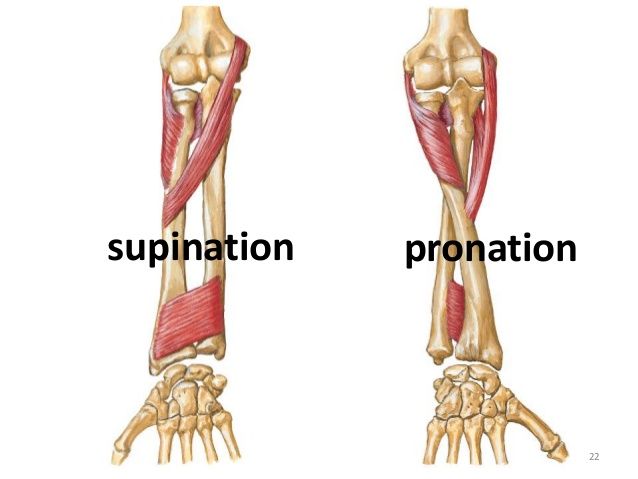Supination is a motion that happens across three independent joints. The proximal radioulnar joint, the distal radioulnar joint, and the elbow joint are characterized by the following characteristics. (specifically the capitular radio portion of the elbow). Let’s dive deep to understand Forearm Supination.
Supination and elbow flexion are two movements that frequently occur together. As a supinator and elbow flexor, the biceps is the strongest of all the muscles that perform each of these tasks. This makes muscular sense because it is the strongest muscle that performs these functions.
Also Read- Pronated Vs Supinated Feet
It happens while turning doorknobs, keys, screwdrivers, and positioning the hand to perform. Other such activities as opening windows, holding huge bowls, trays, and other objects are instances of these two motions being used simultaneously.

The palm is turned upward in hand and forearm supination by rotating the forearm. Torque applied to the forearm in the job is a risk factor for musculoskeletal problems. Workers’ damage and pain are related to tasks that require this form of static or repetitive forearm twisting.
Description of Forearm Supination
Supinator Muscle
The supinator muscle is a forearm muscle found in the posterior compartment. Supination of the forearm is primarily controlled by this muscle, as its name suggests.
Also Read- Walking Vs Running Vs Cycling for Weight Loss
Structure
There are two layers of fibre in the supinator muscle, which is located in the superior and posterior compartments of the forearm. In the mild and rear examples, it encircles about a third of the radius. The radial nerve’s deep branch is placed between these two layers.
Origin
The supinator muscle derives from the ulna and humerus and has a broad origin. Fibres for the two layers of fibres that originate in common include the ulnar supinator, the epicondyle of the humerus, and the annular radial ligament.
In the upper section of the radius, the superficial layer of fibres has a tendinous origin and is surrounded by it. The deeper layer of fibre encircles the neck of the radius above the radial tuberosity; forming a ring around the neck of the radius.
Insertion
Distal to the radial tuberosity, the anterolateral and posterior surfaces of the proximal part of the radius are involved.
Also Read- Common Foot Injuries After Running
Innervation
As the radial nerve enters the supinator muscle, the deep branch of the nerve, which becomes the posterior interosseous nerve, provides the strength.
Function
Supinating the forearm is the primary function of the supinator. The elbow can be in any position of flexion or extension to do this task. If you need a lot of supination, the biceps brachii are the muscles to use as a supinator. When the elbow is extended, the biceps brachii muscle cannot supinate.
Clinical Relevance
Before the supinator muscle, the radial nerve separates into two distinct branches: profound and superficial. This can cause the deep branch of the nerve to get entrapped and compressed; which could lead to selective paralysis of the muscles serviced by this nerve.
Also Read- Spot Jogging Benefits
In addition, a variety of soft-tissue tumours surrounding the nerve and recurrent supination and pronation have been identified as probable causes of this nerve syndrome (referred to as supinator entrapment syndrome).
Assessment
Keeping the patient’s forearm neutral, place their arm and elbow in extension. The proximal third of the radius can be palpated along the posterior portion of the proximal third.
Workplace Testing Explains Supination of Hand and Forearm
An outwardly rotated arm with the palm facing upward or away from the body is the hand & forearm supination. The radius is parallel to the ulna when the wrist is supinated. You use the biceps brachii of your upper arm and the forearm supination muscles for this twisting motion.
The hand, wrist, and forearm spin 180 degrees during full supination. Epicondylitis of the elbow and other cumulative trauma illnesses may develop due to frequent or prolonged supination . As a result of repetitive or prolonged supination of the hand and the forearm, muscular tightness and a decreased range of motion might occur.
Supination can aggravate the consequences of any injuries if the elbow is not bent and the biceps brachii is not used. Forearm-twisting jobs must be taught to employees to reduce the danger of damage. Muscles need to frequently recover and rest in a neutral position. thus, frequent recovery periods are recommended.